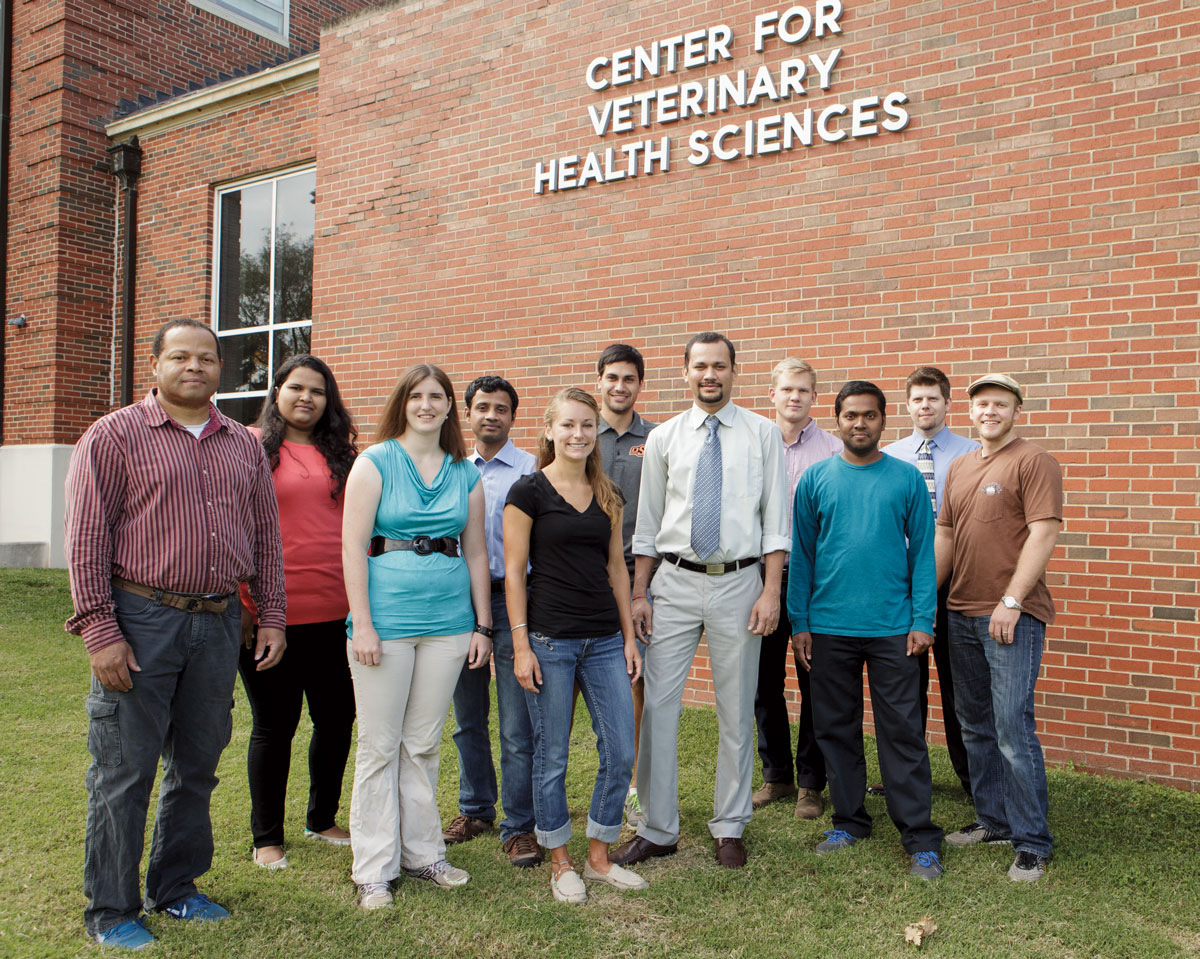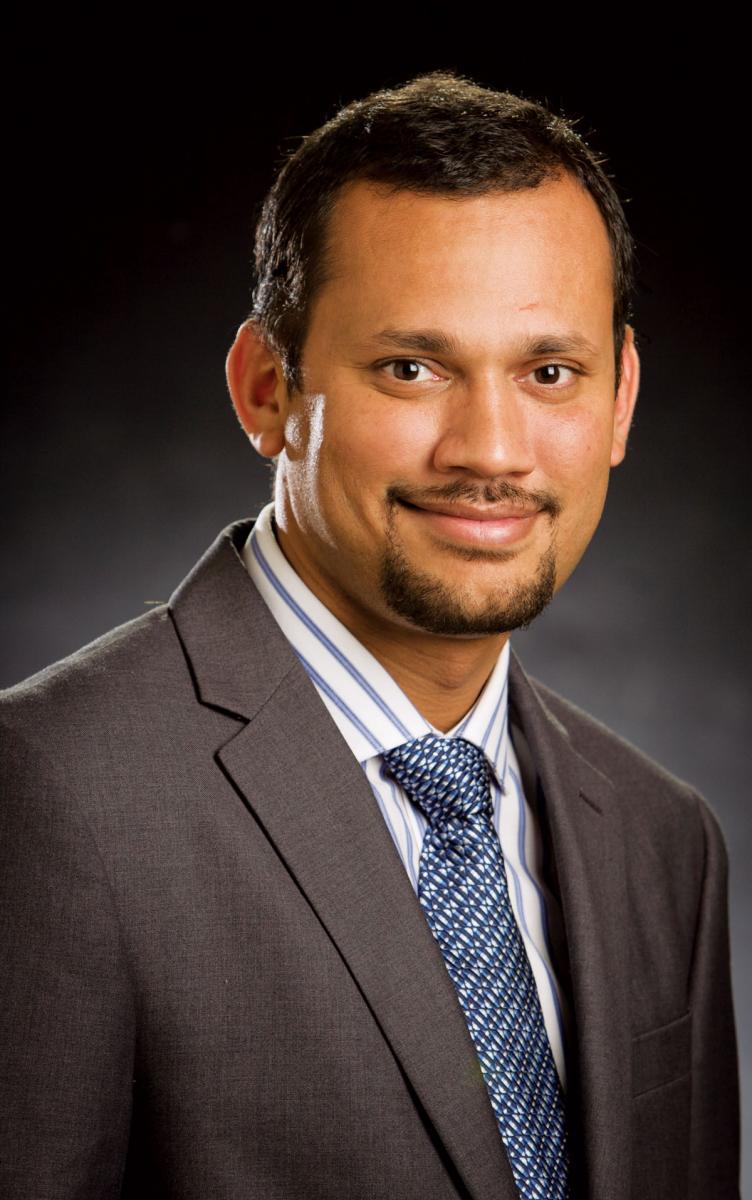Targeting Cancer
Monday, November 9, 2015

Most of us have known someone affected by cancer. Cancer knows no age limit, no financial boundaries and no mercy. But research is helping improve the way we treat this disease and others. And clinical veterinarians, researchers and students at Oklahoma State University’s Center for Veterinary Health Sciences are doing their part to help save lives, animal and human alike.
Ashish Ranjan leads a laboratory of researchers including an undergraduate student, two veterinary students, five Ph.D. candidates, a pre-doctoral fellow and two post-doctoral fellows. He also collaborates with others at in the veterinary center and across OSU. The assistant professor of physiological sciences secures funding through such sources as the National Institutes of Health (NIH), the Oklahoma Center for the Advancement of Science and Technology, and the Oklahoma Center for Respiratory and Infectious Diseases. His research focuses on targeting diseased cells using nanoparticles to deliver disease-fighting drugs.
"Current cancer therapy treatment usually relies on systemic delivery with limited tumor specificity,” says Ranjan. “This may result in adverse side effects in normal tissues and insufficient drug delivery to the targeted cancerous tumor. Encapsulation of a chemotherapeutic agent into a nanoparticle has the potential to reduce systemic toxicity and enhance drug delivery. For cancer targeting, we are pursuing two parallel approaches to address this critical need. One involves development of image-guided drug delivery, and the other involves optimizing concurrent combinations of radiation and chemotherapy.”
For image-guided drug delivery, Ranjan’s team uses a simultaneous combination of drug encapsulated imageable nanocarriers with clinical imaging devices for more accurate targeting.
“Basically, our team is developing nanoparticles that can be imaged using ultrasound and simultaneously achieve drug delivery under image guidance. For example, a team member will use a liposome, which is a vesicle or a bubble, and fill it with a cancer-fighting drug that can be detected on ultrasound. Then, using a specialized ultrasound, we are able to achieve site-specific delivery, treating the diseased area directly without harming surrounding healthy cells. Our team is trying to perfect this new technique, which has the same amount of efficacy as current protocols but with zero side effects,” adds Ranjan.
Similarly, the concept of concurrent combinations of radiation and chemotherapy is based on the premise that radiation can be leveraged to localize nanoparticles in tumors and trigger drug release from them.
“The ability to achieve non-toxic, selective chemotherapy with real-time assessment has applications in a variety of diseases including cancer. Our lab realizes this potential and while research on cancer constitutes the primary area of work, we are also investigating the therapeutic application of nanomedicine against chronic infection and thrombotic disease,” says Ranjan.

Among those working in Ranjan’s lab is Peter Czajkowski, a second-year veterinary student from Peachtree Corners, Ga. Czajkowski applied the nanotechnology to see if it could treat thrombolysis by effectively breaking down blood clots in patients both animal and human. His original study was part of a 12-week Summer Research Training Program for first- and second-year veterinary students. He soon discovered that research can take you down unexpected paths.
“It was a great experience,” says Czajkowski. “The one thing I walked away from this knowing was how much work goes into a research project. Originally I thought it would be easily done in the three-month period. Realistically, it is not done. So I am taking an elective to do a follow-up study that will hopefully further improve this technique.”
“The Summer Research Training Program at OSU’s veterinary center is a great initiative,” adds Ranjan. “It motivated Peter in such a way that he is continuing that project. The data which Peter generated and will come to generate can certainly be used for many other projects in our laboratory.”
"Medical applications of nanotechnology promise to revolutionize our ideas about healthcare delivery in both humans and in our veterinary patients in areas such as drug delivery or new technologies like nanoscale biosensors,” says Jerry Malayer, associate dean for research and graduate education. “Targeted drug delivery will reduce the amount of drug needed and possibly reduce side effects of drugs which could result in overall decreases in treatment costs. It is important for us to always be thinking about applications of new technologies and staying close to the edge of scientific developments.”
Ranjan oversees several projects in his laboratory, all aimed at using nanomedicine to treat life-threatening diseases. Here is a brief description of six such projects:
• Image-guided tumor drug delivery by ultrasound-detected heat-released liposome: This research focuses on developing an imageable nanoparticle for localizing and treating cancer in combination with a high-intensity focused ultrasound device. It is funded by the National Cancer Institute at NIH. Kevin Mclean, an undergraduate student and Wentz scholar, and Danny Maples, a chemistry major and pre-doctoral fellow, work with Ranjan on this project.
• Nanotherapeutic modulation of autophagy (or cell death) for treatment of lung pathogens: Chronic intracellular infection, such as tuberculosis, requires frequent administration of antibiotics for long durations such as six to nine months. To address this, the team is developing a multifunctional nanoplatform for targeting and killing chronic intracellular bacterial pathogens. The study is made possible through funding from the Oklahoma Center for Respiratory and Infectious Diseases, which was created from a NIH Centers for Biomedical Research Excellence grant. Working with Ranjan and Malayer are Ph.D. students Michele Harbeson and Willie Collins.
• Trackable nanocarriers for rational dosimetry (measurement of doses): Nanoparticles are normally tested in rodents. Attempts to translate the findings from rodent studies directly into humans have met with dismal clinical outcomes. This project focuses on determining the kinetics of echogenic liposomes in a clinically relevant large-animal tumor model and compares the results with a rodent model to ease translation to human patients. Danny Maples, a chemistry major and pre-doctoral fellow, and Selvarani Ramasamy, a Ph.D. student, work with Ranjan on this study, which is funded by the Oklahoma State University Technology Business Development Program.
• Dual-mode ultrasound-imageable thermosensitive liposomes for image-guided therapy: Prostate cancer is one of the most common cancers among men in United States. Current therapy results in significant morbidity among patients. This research is investigating the thermal enhancement of chemotherapy under image guidance with an overall goal of dose reduction and increasing survival rates. Working with Ranjan are Kalyani Ektate and Aaron Deese, Ph.D. students, and Perumal Venkatesan, a post-doctoral fellow. The work is funded by the Oklahoma Center for the Advancement of Science and Technology.
• Nanocarrier-mediated targeting of bioscavengers to the red blood cell for prolonged circulation and protection: This project will systematically design and characterize co-polymer nanoparticles encapsulating the bioscavenger enzyme BChE that can be selectively targeted to red blood cells. Once attached to or inside red blood cells, the nanoparticles will circulate in the blood for weeks to months, providing prolonged and enhanced protection against organophosphate intoxication. Funded by the U.S. Department of Defense through the Defense Threat Reduction Agency, these researchers are collaborating on the project: Regents Professor Carey Pope (principal investigator); Ranjan and Jing Pope (co-investigator), all with the veterinary center’s Department of Physiological Sciences and Josh Ramsey of Chemical Engineering and Steve Hartson of Arts and Sciences. Also working on the project is Kaustuv Sahoo, a postdoctoral fellow in Ranjan’s lab.
• High-intensity focused ultrasound mediate clot-lysis: Funded by OSU’s Center for Veterinary Health Sciences, this study aims to develop nanoparticles that can induce clot-lysis (or a blood clot) in combination with a high-intensity focused ultrasound. Second-year veterinary student Peter Czajkowski and third-year veterinary student Alison Gedney work with Ranjan on this research.
While the projects vary and the financial funding comes from different sources, the goals are the same: minimize side effects and enhance therapeutic outcomes in animals and humans.
To play a role in fighting cancer or other life-threatening diseases by supporting veterinary medical research at OSU’s Center for Veterinary Health Sciences, contact Heather Clay, senior director of development, at 405-385-5607 or hclay@osugiving.com.
